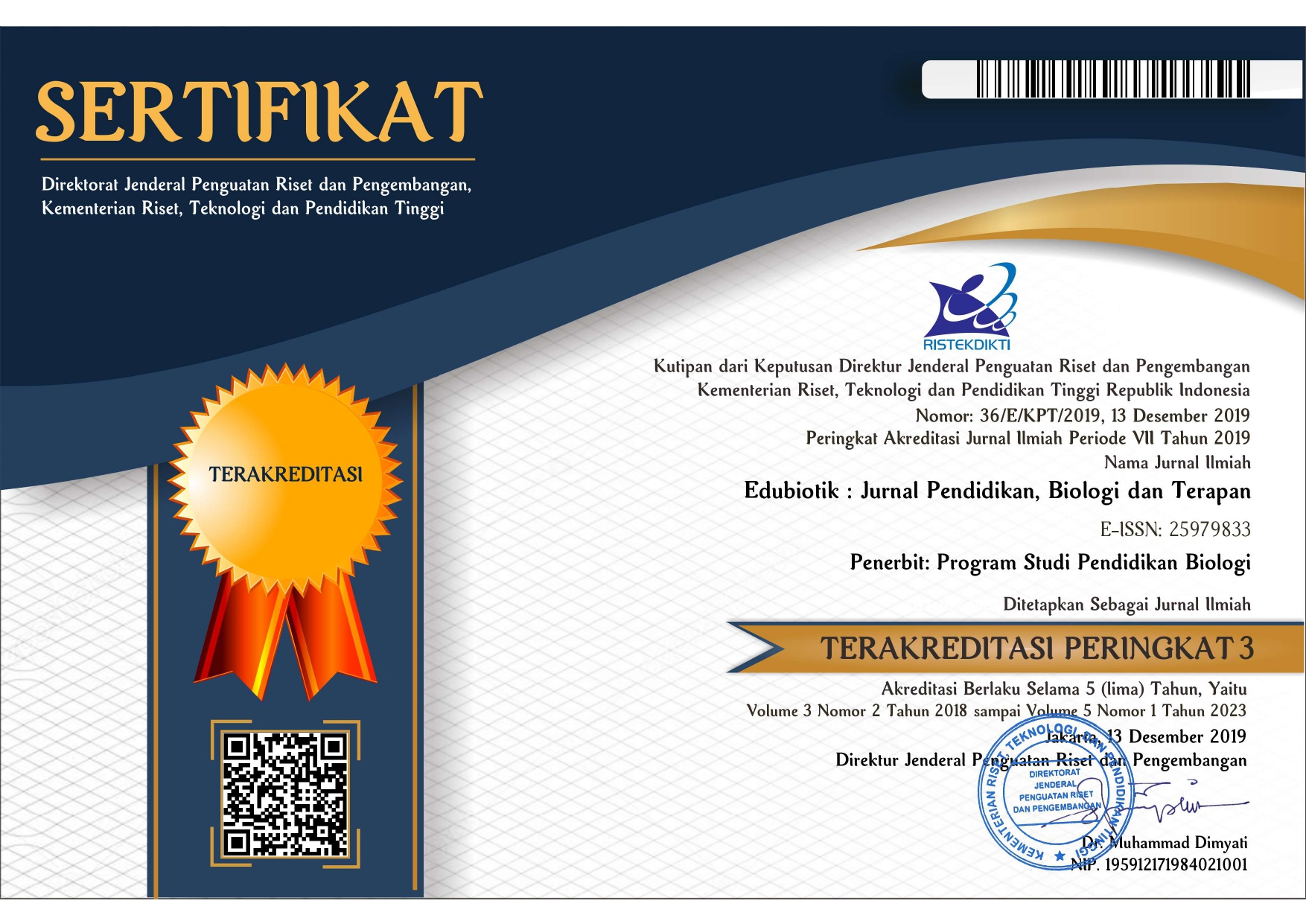Identifikasi tumbuhan dalam masakan tradisional urap-urap sebagai materi penyusunan buku referensi taksonomi tumbuhan
Abstract
One of the conservation efforts that needs to be implemented is plant exploration activities as local wisdom. There are various forms of local wisdom and one of them is traditional cuisine. This study aims to identify the types of plants used in traditional East Javanese cuisine, namely urap-urap. The types of plants that were identified obtained from the interview to the informant using an interview guide. Plant identification is done through direct observation using the observation sheet and the results compared with a reference scientific identification. Data were analyzed by descriptive qualitative. The results showed that there were 13 types of plants identified in traditional cuisine namely urap-urap, four types including the Monocotyledonae class and nine other types were members of the Dicotyledonae class. The 13 types of plants include Allium cepa, Allium sativum, Capsicum anuum, Capsicum frutescens, Citrus hystrix, Vigna radiata, Vigna sinensis, Ipomoea reptans, Cocos nucifera, Ocimum sanctum, Caempferia galanga, Cucumis sativus, and Caricaaya. This research concludes that 13 types of plants have been identified in traditional Javanese ointment which is Monocotyledonae and Dicotyledonae classes.
References
Adrianto, H., Yotopranoto, S., & Hamidah. (2014). Effectivity of Kaffir lime (Citrus hystrix), Nasnaran Mandarin (Citrus amblycarpa), and Pomelo (Citrus maxima) Leaf Extract Against Aedes aegypti Larvae. Aspirator, 6(1), 1–6. Retrieved from http://ejournal.litbang.depkes.go.id/index.php/aspirator/article/view/3516
Alam, M. K., Hoq, M. O., & Uddin, M. S. (2016). Medicinal plant Allium sativum = A Review. Journal of Medicinal Plants Studies JMPS, 72(46), 72–79. Retrieved from http://www.plantsjournal.com/archives/?year=2016&vol=4&issue=6∂=B&ArticleId=463
Al-snafi, A. E. (2015). The Pharmacological Importance of Capsicum Species (Capsicum annuum and Capsicum frutescens) Grown in Iraq. Journal of Pharmaceutical Biology, 5(3), 124–142. Retrieved from https://www.semanticscholar.org/
Asrullah, M. (2015). Kecambah Kacang Hijau Dan Efikasinya Terhadap Kesehatan. Bimgi, 3(2), 30–35. Retrieved from https://issuu.com/bimkes/docs/bimgi_vol_3_no_2
Bhatt, K. J. (2015). Ocimum Sanctum : The Indian Medicinal plant. International Journal of Chemtech Applications, 3(1), 53–57. Retrieved from https://www.researchgate.net/directory/publications
Foong, F. H. N., Mohammad, A., & Ichwan, S. J. A. (2015). Biological properties of cucumber (Cucumis sativus L.) extracts. Malaysian Journal of Analytical Sciences, 19(6), 1218–1222. Retrieved from http://www.ukm.my/mjas/mjas2018/
Iskandar, J. (2016). Etnobiologi dan Keragaman Budaya di Indonesia. Indonesian Journal of Anthropology, 1(1), 27–42. https://doi.org/10.24198/umbara.v1i1.9602
Kelana, H. W., Hidayat, T., & Widodo, A. (2016). Pewarisan Pengetahuan dan Keterampilan Identifikasi Keanekaragaman Tanaman Padi Lokal pada Generasi Muda Kasepuhan Adat Banten Kidul. In Proceeding Biology Education Conference (Vol. 13, pp. 255–262). Retrieved from https://jurnal.uns.ac.id/prosbi/%20article/view/5712
Khan, F. A., Mahmood, T., Ali, M., Saeed, A., & Maalik, A. (2014). Pharmacological importance of an ethnobotanical plant: Capsicum annuum L. Natural Product Research: Formerly Natural Product Letters, 28(16), 1267–1274. https://doi.org/10.1080/14786419.2014.895723
Kumar, K. P. S., Bhowmik, D., Chiranjib, Biswajit, & Tiwari, P. (2010). Allium cepa: A traditional medicinal herb and its health benefits. Journal of Chemical and Pharmaceutical Research, 3(4), 773–776. Retrieved from http://www.jocpr.com/abstract/allium-cepa-a-traditional-medicinal-herb-and-its-health-benefits-44.html
Piranti, L., & Muliyati, D. (2016). Pengembangan Buku Referensi Berbasis Multi Representasi dengan Pendekatan Kontekstual pada Materi Kalor dan Termodinamika. In SNIPS 2016 (pp. 495–300). Retrieved from http://portal.fmipa.itb.ac.id
Prabawati, T. P., & Pujimulyani, D. (2018). Pengaruh Penambahan Ekstrak Kencur (Kaempferia galanga). In Seminar Nasional Inovasi Pangan Lokal untuk Mendukung Ketahanan Pangan 2018 (pp. 209–216). Yogyakarta. Retrieved from http://ejurnal.mercubuana-yogya.ac.id/index.php/Prosiding_IPPL/article/view/731
Pratiwi, F. M., & Sutara, P. K. (2013). Etnobotani kelapa (Cocos nucifera L.) Di Wilayah Denpasar dan Badung. Jurnal Simbiosis, 1(2), 102–111. Retrieved from https://ojs.unud.ac.id/index.php/simbiosis/article/view/7713/5802
Ridwan, Hastuti, D., & Prabowo, R. (2014). Analisis Pendapatan Petani Kangkung Darat (Ipomea Reptans Poir) Tradisional. Mediagro, 10(2), 81–89. Retrieved from https://publikasiilmiah.unwahas.ac.id/index.php/Mediagro
Salima, J. (2015). Antibacterial Activity Of Garlic (Allium sativum l .). Jurnal Majority, 4(2), 30–39. Retrieved from http://juke.kedokteran.unila.ac.id/index.php/majority/article/view/523
Simarmata, E. R., Ardian, & Sa’diyah, N. (2015). Penampilan Karakter Produksi Kacang Panjang (Vigna sinensis L.) Generasi F1 Dan Tetuanya. Jurnal Agrotek Tropika, 3(3), 303–308. Retrieved from http://jurnal.fp.unila.ac.id/index.php/JA/article/view/1950
Sudarwati, T. P. L. (2018). Aktivitas Antibakteri Daun Pepaya (Carica Papaya) Menggunakan Pelarut Etanol Terhadap Bakteri Bacillus subtilis. Journal of Pharmacy and Science, 3(2), 13–16. Retrieved from https://www.akfarsurabaya.ac.id/ejournal/index.php/jps/article/view/105
Sudhakar, N., & Theivanai, V. R. (2014). Potential medicinal properties of Carica papaya Linn. Int J Pharm Pharm Sci, 6(2), 2–5. Retrieved from https://www.semanticscholar.org/
Susiarti, S., & Setyowati, F. M. (2005). Bahan Rempah Tradisional dari Masyarakat Dayak Kenyah di Kalimantan Timur. BIODIVERSITAS (Journal of Biological Diversity), 6(4), 285–287. https://doi.org/10.13057/biodiv/d060415
Tjitrosoepomo, G. (2009). Morfologi Tumbuhan. Yogyakarta: Gadjah Mada University Press. ISBN: 978-979-420-241-8
Tyas, A. S. P. (2017). Identifikasi Kuliner Lokal Indonesia dalam Pembelajaran Bahasa Inggris. Jurnal Pariwisata Terapan, 1(2), 38. https://doi.org/10.22146/jpt.24970
Wibowo, H. Y., & Sitawati. (2017). Respon Tanaman Kangkung Darat (Ipomoea Reptans Poir) Dengan Interval Penyiraman Pada Pipa Vertikal Respons Of Kangkong (Ipomoea reptans Poir) Watering Interval On. Plantropica, 2(2), 148–154. Retrieved from https://jpt.ub.ac.id/index.php/jpt/article/view/142
Zulharman, Yanuwiadi, B., & Batoro, J. (2015). Etnobotani Tumbuhan Obat dan Pangan Masyarakat Suku Sambori Kabupaten Bima Nusa Tenggara Barat Indonesia. Natural-B, 3(2), 198–204. http://dx.doi.org/10.21776/ub.natural-b.2015.003.02.15





.png)
2.png)

1.jpg)


